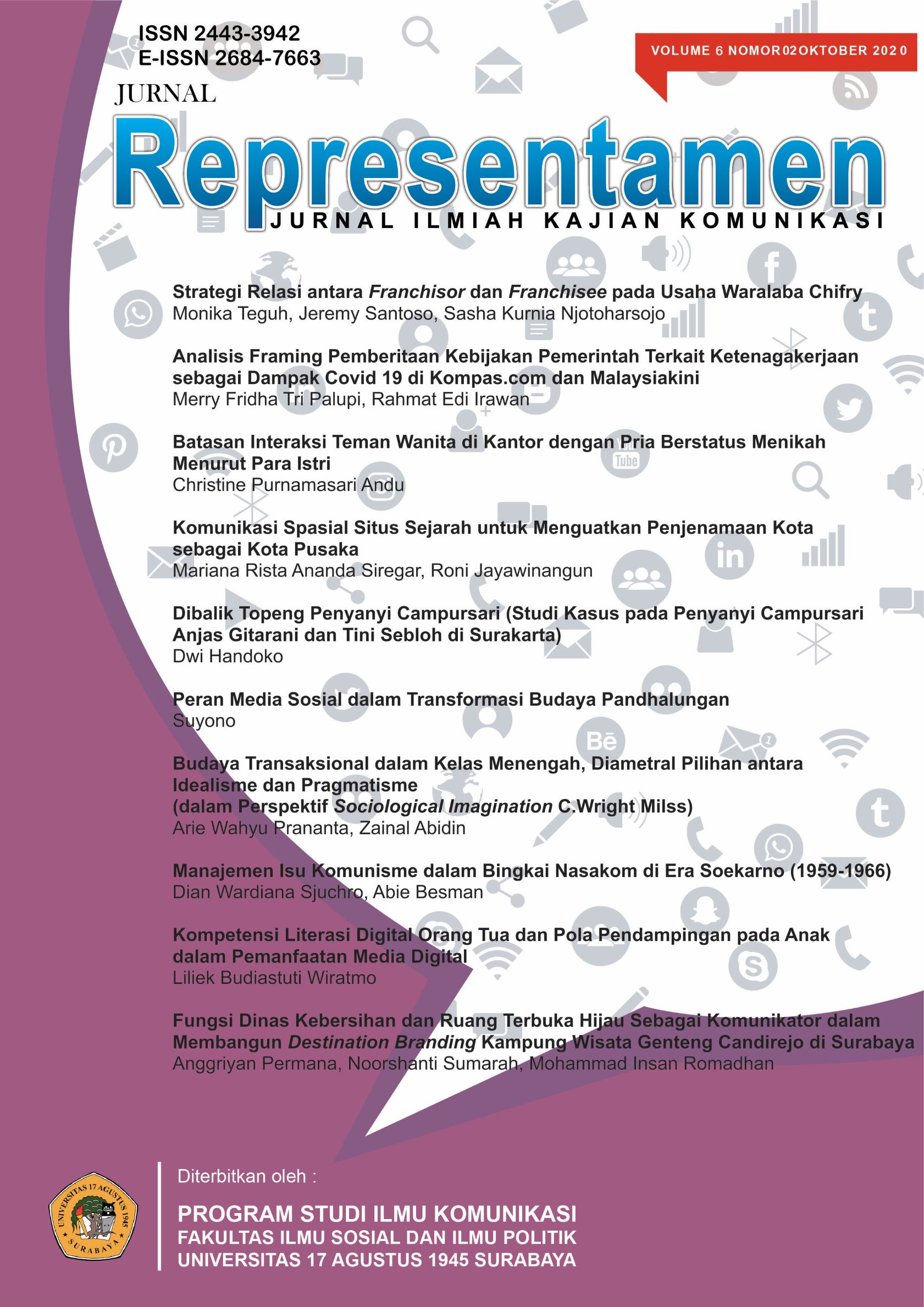Komunikasi Spasial Situs Sejarah untuk Menguatkan Penjenamaan Kota sebagai Kota Pusaka
DOI:
https://doi.org/10.30996/representamen.v6i02.4264Abstract
Abstract
This article was written in order to describe the preservation of cultural spatial assets in support of one of the pillars of the city of Bogor, which imagines the city as a Heritage City. Based on the results of research on the image of the city of Bogor as a place (place branding), the city tourism often offers historical heritage from various times. The Bogor City Government seems to see the superiority of this heritage as an asset to increase their own local income. The qualitative data of this study were obtained from a review of archives and policy documents, reinforced by quantitative data collected through questionnaires to the Bogor community regarding the spatial heritage assets in their city. The results showed that through the form of primary communication in the form of landscape strategies, infrastructure, and cultural behavior, people feel well the stimuli of their city which can image their city as a Heritage City. This is supported by the implementation of policies contained in the Regional Medium Term Development Plan which includes the revitalization of historical sites, strengthening of footpaths around the Bogor Botanical Gardens, and holding various events based on Indonesian national culture.
Keywords: spatial communication, place naming, city naming, heritage cityDownloads
References
Abdurrasyid, Priyatna., 2002, “Arbitrase dan Alternatif Penyelesaian Sengketa Suatu Pe-ngantar”, Fikahati Aneska, Jakarta.
Abbas, Syahrizal., 2009, “Mediasi Dalam Persfektif Hukum Syariah, Hukum Adat, Dan Hukum Nasional”, Kencana Prenada Media Group, Jakarta.
Astria Yuli Satyarini Sukendar, Amanda Raisaa dan Tomy Michael, Penjualan Rogodi (Roti Goreng Mulyodadi) Sebagai Usaha Bisnis Dalam Meningkatkan Usaha Mikro Kecil (UMK) Di Desa Mulyodadi, Kabupaten Sidoarjo, Jurnal Hukum Bisnis Bonum Com-mune Volume 3 Nomor 1 Februari 2020.
Bintang, Sanusi., dan Dahlan., 2000, “Pokok-pokok Hukum ekonomi dan Bisnis” Citra aditya Bakti, Bandung.
Head, Jonh W., 1997, “Pengantar Umum Hukum Ekonomi” , ELIPS, Jakarta.
http://www.cybertokoh.com/mod.php?mod=publisher&op=viewarticle&a rtid=1037, “Me-diasi: solusi dan Alternatif sengketa di luar pengadilan”, diakses tanggal 9 Desember 2019.
Margono, Sujud., 2004, “ADR (Alternative Dispute Resolution) dan Arbitrase Proses Pelem-bagaan dan Aspek Hukum” Ghalia Indonesia, Bogor.
Rahardjo, Satjipto., 2006, “ilmu Hukum”, PT. Citra aditya Bakti, cet. Ke 6, Bandung.
Rahmadi, Takdir., 2011, ”Mediasi penyelesaian sengketa melalui pendekatan mufakat”, PT RajaGrafindo Persada, Jakarta.
Sentosa, Achmad., 1995, “Alternative Dispute Resolution (ADR) di Bidang Lingkungan Hi-dup” Makalah ini disampaikan dalam Acara Farum Dialog tentang Alternative Dispu-te Resolution (ADR) yang diselenggarakan oleh Tim Pakar Hukum Departemen Kehakiman dan Asia Foundation, Jakarta
Sukadana, I Made., 2012, “Mediasi Peradilan: Mediasi Dalam Sistem Peradilan Perdata Indonesia Dalam Rangka Mewujudkan Proses Peradilan Yang sederhana, Cepat dan Biaya Ringan” Prestasi Pustaka, Jakarta.
Usman, Rachmadi., 2003, “Pilihan Penyelesaian Sengketa di Luar Pengadilan”, PT. Citra Aditya Bakti, Bandung.
-----------., 2012, “Mediasi di Pengadilan dalam Teori dan Praktik” Sinar Grafika, Jakarta. Widjaja, Gunawan., 2002, “Alternatif Penyelesaian Sengketa” RadjaGrafindo persada” Jakarta.
Efendi Jonaedi, Ibrahim Johnny, 2018, “Metode Penelitian Hukum: Normatif dan Empiris, Prenada Media”, Prenada Media, Jakarta.
Downloads
Published
Issue
Section
License
Authors whose manuscript is published will approve the following provisions:
The right to publication of all journal material published on the jurnal representamen website is held by the editorial board with the author's knowledge (moral rights remain the property of the author).
The formal legal provisions for access to digital articles of this electronic journal are subject to the terms of the Creative Commons Attribution-ShareAlike (CC BY-SA) license, which means Jurnal Representamen reserves the right to store, modify the format, administer in database, maintain and publish articles without requesting permission from the Author as long as it keeps the Author's name as the owner of Copyright.
Printed and electronic published manuscripts are open access for educational, research and library purposes. In addition to these objectives, the editorial board shall not be liable for violations of copyright law.











